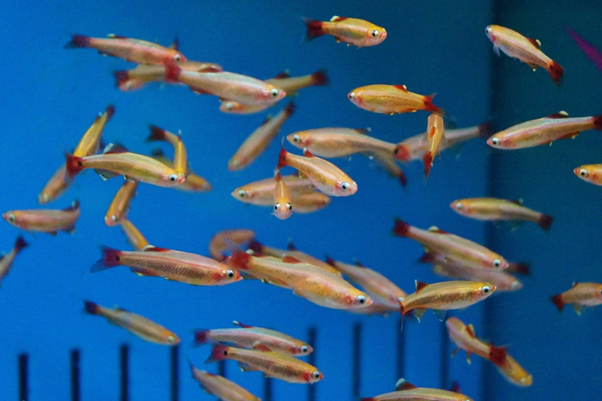Temperate fish - the smart alternative to goldfish
Let’s look at temperate fishes. They’re not cold water but they’re not tropical either – most importantly they thrive at room temperature. The most significant aspect is that they’re a far better choice for modestly sized set ups than goldfish.

Gold White Cloud Mountain minnows https://www.fishkeeper.co.uk/fish/freshwater/cyprinids/white-cloud-mountain-minnow-
As we see in the UK, the climate can be subject to some dramatic changes. Unlike the tropics, we have four seasons a year compared to the two which are a feature of many regions that experience less temperature variation between the dry and wet seasons. Of course, it could be argued that we’re often enjoying a wet season rather than winter/spring/summer/autumn, but at least British rain is warmer in the summer!
So, what is cold water? Think of trout in Scottish lochs, or gobies sitting on the bottom of Lake Baikal. These environments don’t approach the temperatures seen in unheated aquaria in the summer. This is why we prefer the term temperate instead.
Without a doubt, aquarium fishes are adaptable and can tolerate many of the temperature changes that we throw at them but a look at their ancestral habitats can tell us which species are most likely to thrive without heating. Many regions of the world are classified as subtropical and have seasonal variations that include periods of tropical temperatures, followed by significantly cooler months. These are home to many of the fishes that we regard as temperate. Mild winters in these regions might mean that snow is not unknown but cold nights are usually followed by warm days, giving a Mediterranean climate that allows fish to recover and remain active. The other habitats that are home to temperature-tolerant species are the high-altitude regions of tropical countries. Here, melt water can make conditions chilly before flowing down into warmer surroundings.
Classically tropical species such as Cardinal tetras which inhabit shady Amazonian creeks aren’t subjected to much temperature variation, aside from a drop of a few degrees when heavy rains are accompanied by dark clouds that block the sun. Having said that, many tropical species are often found in habitats where day and night temperatures swing within a certain range, especially those that find themselves exploiting floodwaters exposed to hot sunlight. By contrast larger bodies of water are more stable with the almost unimaginable water volumes of Rift Lakes such as Tanganyika being very resilient to temperature swings. There’s a reason behind the phrase ‘a drop in the ocean’ after all.
Many species from subtropical regions are already familiar aquarium inhabitants and were often popular fishes in the early days of the hobby, when primitive heating equipment meant that temperatures would fluctuate, and winters dropped low enough to challenge more delicate fish. It’s important to remember that these aren’t tropical fishes tolerating low temperatures, but creatures adapted to thrive and benefit from a seasonal rest. Many of these are community tank staples but are far healthier and longer-lived when kept at room temperature and sometimes even lower. A tropical aquarium will generally expose them to an ‘eternal summer’ where the demands of a hyperactive metabolic rate will cause them to live fast and die young. Kept in a home with central heating, they’ll experience their natural cycle, where summer temperatures lie within the tropical range but fall by 8-10C for a few months in winter.

Odessa barb https://www.fishkeeper.co.uk/fish/freshwater/cyprinids/odessa-barb
Most of our stores have numerous tanks dedicated to these cool customers so you’ll find a surprising range of choices on offer, many of which are more than a match for goldfish and far easier to keep too.
You’ll also find much more information on the temperature preferences of individual species in our Databank: https://www.fishkeeper.co.uk/fish/freshwater/


